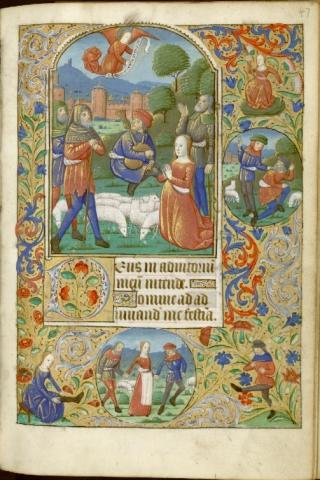

“Memory has two doors, pictures and words.” Richard de Fournival
UCLA’s Special Collections contain more than 300 manuscripts. In the winter 2014, a selection of these materials was put on view. The press release, which referenced the “dazzling visual splendor” of the manuscripts, noted that they contained “stunning illustrations, historiated initial, and elaborate penwork on parchment and paper.” It went on to say that the “...exhibit contents focus on illuminations in bound manuscripts, many being shown for the first time.”
Professor Richard Rouse, UCLA Professor emeritus of History, who with his wife Mary Rouse, has been responsible for considerable contributions and work in this collection, writes that these include “manuscripts ranging in date from the late ninth to the fifteenth century and in origin from across Western Europe and Byzantium and in Latin, Greek, and the Western vernacular languages.” Languages represented include Latin, English, French, Italian, Netherlandish, Spanish, Armenian, Persian and Ge’ez. He went on to say of the exhibit, ”A selection of individual manuscript leaves and documents, some with wax seals still intact, complements the bound items. The exhibit is organized by geography, enabling viewers to trace differences in styles of illumination, illustration and script that developed regionally over time.”
Professor Rouse also commented on the fact that many of the images were being shown for the first time. “The collection is supported by an endowment from the J. Paul Getty Foundation, with additional annual support from Richard and Mary Rouse. There are also over 240 individual manuscript leaves and documents.” Gifts from the Rouse Collection complement materials held elsewhere at UCLA--in the Elmer Belt Library of Vinciana, in the Louise M. Darling Biomedical Library, in the John E. Anderson Graduate School of Management, and in the Music Library. Professor Rouse’s intention is that: ”These collections of medieval and Renaissance manuscripts, well begun, will continue to grow and to serve the students and faculty at the University of California as a record of human endeavor long after we are gone.”
Though built on a comparatively modest budget, the UCLA Library‘s collection of medieval and Renaissance manuscripts displays a wide range of artistry. The Library began its collection, primarily through gifts, in 1941. With the strong support of University Librarian Lawrence Clark Powell and former Chancellor Franklin Murphy, the collection grew more rapidly after 1958. In 2000, The Getty Trust provided an endowment, which has allowed the collection to expand in scope and breadth.
The 2014 exhibit was curated by Richard H. Rouse, and his wife Mary. Both have played a central role in building a teaching and research collection to be used by faculty and students. In 2005 the Rouses more than doubled the size of the collection through a series of generous donations of their own collection. They have also utilized the collection in depth to teach paleography and the history of the book at UCLA.
Professor Rouse expressed his appreciation to the Special Collections Library as follows, “I am grateful to Tom Hyry, Director of UCLA Library Special Collections, and Genie Guerard, Curator of Manuscripts, for their encouragement and support; I thank Jesse Erickson, who indexed the manuscripts by author, date and place of origin, and contents. I am especially indebted to my friend and colleague Octavio Olvera, Visual Arts Specialist, for the mounting and arrangement of the exhibit.”
This online exhibit is a tiny representation, comprised of just more than a dozen manuscripts, to provide a glimpse of the riches of the collection. Labels and comments are taken from the exhibit labels prepared by Richard and Mary Rouse. Comments in this introduction were culled from the Rouse’s introduction to that exhibit and the press release prepared by Dawn Setzer for the exhibit in 2014. We are extremely grateful to all of them for letting us use these materials as part of the HoB online project.
Johanna Drucker
